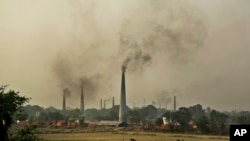A new study said that cleaning up dirty air could prevent up to 2.1 million premature deaths every year, mostly in Asia, but also in countries with relatively cleaner skies.
Air pollution, related illness
The adverse health impacts of inhaling tiny particulate matter that lodges deep inside lungs have long been known, they are associated with increased risk of heart attacks, strokes, respiratory illnesses and lung cancer.
A team of U.S. based environmental engineering and public health researchers have prepared a new global model to determine the extent to which people would benefit if air pollution, from what is called PM, is cut to those limits specified by the World Health Organization (WHO).
Assistant professor of environmental engineering at the University of Texas, Austin, Joshua Apte, led the study. “About 75 percent of the total number of deaths that could be avoided from cleaner air could come from improving air in some of the most polluted parts of the world like India and China,” he said. "Those benefits could be as large as many of the other public health things we might like do globally like addressing major diseases like malaria and AIDS.”
Reducing mortality
The study estimates that cutting outdoor air pollution could save 1.4 million lives in places like India and China.
But the goal is tough. The study said that even to cut mortality by half, India and China would need to reduce pollution levels by nearly 70 percent from 2010 levels.
In some places like New Delhi, PM concentrations are sometimes 10 times higher than that specified by WHO.
The two countries are home to some of the world’s most polluted cities. India has 13 of the world’s 20 most polluted cities. The Indian capital, New Delhi, tops the chart.
The study also warns that even if pollution levels remain constant, mortality rates would jump by over 20 percent in India and China. Apte explained that would be due to the changing demographic profile of these countries over time.
“For countries that are right now quite young, but are getting older, and India and China are two examples of such countries, as the population just get older over time, the per capita impact of air pollution increases, because the number or fraction of people who are old enough to be risk of heart attack and stroke also goes up,” Apte stated.
Improving air quality
But the task of clearing the skies is a massive challenge for both India and China where coal continues to be the main source to generate power and where city roads are becoming choked by vehicles owned by the growing middle class.
While China has done some work in cleaning the air, experts worry that air pollution could worsen in India, which wants to scale up the number of coal fired plants to feed a growing economy.
About 100 scientists and academics who met recently at a workshop organized by the Indian Association for Air Pollution Control in New Delhi regretted that Indian authorities have taken little action to curb air pollution despite the serious health consequences.
Air quality expert, P.K. Dave, called for a sustained public campaign to tackle fumes from industry and traffic. “One is to create awareness and campaign to force the government to take action,” he said. “They need to act now and now only.”
The latest study shows that cleaner regions could also benefit from improving air quality. Researchers were surprised to find that even places with relatively cleaner air such as North America and Europe could save half a million lives per year by meeting WHO air quality guidelines.
The study reinforces WHO's declaration last month that air pollution is the world’s single biggest environmental health risk.







